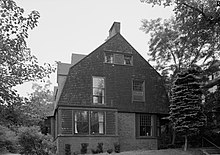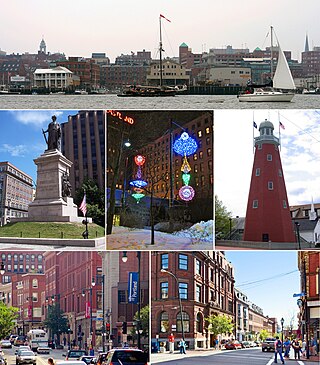
Portland is the most populous city in the U.S. state of Maine and the county seat of Cumberland County. Portland's population was 68,408 in April 2020. The Greater Portland metropolitan area has a population of approximately 550,000 people. Historically tied to commercial shipping, the marine economy, and light industry, Portland's economy in the 21st century relies mostly on the service sector. The Port of Portland is the second-largest tonnage seaport in the New England area as of 2019.

Waynflete School is a private, co-educational, college preparatory day school established in 1898 for early childhood education to the 12th grade. It is located in the West End of Portland, Maine.
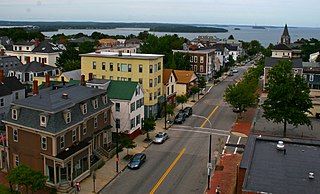
Munjoy Hill is a neighborhood and prominent geographical feature of Portland, Maine. It is located east of downtown and south of East Deering. In the nineteenth and twentieth centuries, the neighborhood had a large Irish and Italian American population.

The Thomas Brackett Reed House is a historic brick duplex house at 30–32 Deering Street in Portland, Maine. Built in 1876, the house was designated a National Historic Landmark in 1975 for its association with Thomas Brackett Reed (1839–1902), Speaker of the House of Representatives. Reed owned and occupied number 32 from 1888 until his death in 1902. He was notable for significantly increasing the power of the House Speaker, introducing a set of rules known as the Reed Rules that still govern debate in that body today.
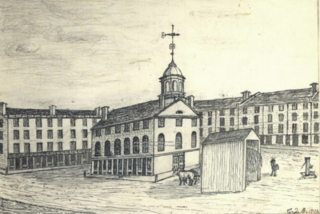
The History of Portland, Maine, begins when Native Americans originally called the Portland peninsula Məkíhkanək meaning "At the fish hook" in Penobscot and Machigonne in Algonquian. The peninsula and surrounding areas were home to members of the Algonquian-speaking Aucocisco branch of the Eastern Abenaki tribe, who died largely due to the introduction of foreign illnesses during colonization. Some were forcibly relocated to current day New Hampshire and Canada during European settlement.
Portland, Maine, is home to many neighborhoods.
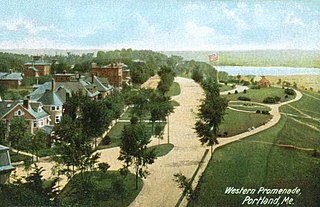
Bramhall Hill is a hill in the west and southwest of the downtown peninsula of Portland, Maine. At its summit, the hill stands 171 feet (52 m) feet above sea level, with a sharp drop below. The area includes the West End neighborhood, the Western Promenade and part of the Old Port downtown district.

The Hamblen Block is a historic series of four row houses at 188–194 Danforth Street in Portland, Maine, United States. Built in 1835, it is one of the oldest such buildings in the state, and also a rare example, as comparatively few row houses were built anywhere in Maine. The row houses were added to the National Register of Historic Places in 1983, and are a contributing property to the larger Hamblen Development Historic District.

The Western Promenade is a historic promenade, an 18.1-acre (7.3 ha) public park and recreation area in the West End neighborhood of Portland, Maine. Developed between 1836 and the early 20th century, it is one Portland's oldest preserved spaces, with landscaping by the Olmsted Brothers, who included it in their master plan for the city's parks. The promenade was listed on the National Register of Historic Places in 1989.

The Western Promenade Historic District encompasses a late 19th-and early 20th-century neighborhood in the West End of Portland, Maine. This area of architecturally distinctive homes was home to three of the city's most prominent architects: Francis H. Fassett, John Calvin Stevens, and Frederick A. Tompson, and was Portland's most fashionable neighborhood in the late 19th century. The district was listed on the National Register of Historic Places in 1984.
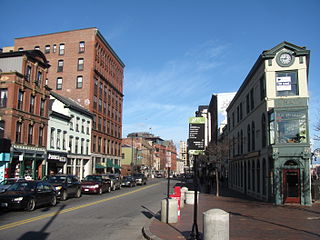
Congress Street is the main street in Portland, Maine. Around 5.77 miles (9.29 km) long, it stretches from County Road, Portland's southwestern border with Westbrook, through a number of neighborhoods, before ending overlooking the Eastern Promenade on Munjoy Hill. In March 2009, the Portland City Council designated much of the inner portion of Congress Street a historic district. The western section of the street includes the city's Arts District.

The Spring Street Historic District encompasses surviving elements of the 19th-century commercial and surviving residential areas of Portland, Maine. Encompassing a portion of the city's Arts District and an eastern portion of its West End, the district has a significant concentration of residential and commercial buildings that survived the city's devastating 1866 fire. The district was listed on the National Register of Historic Places in 1970.
The following is a timeline of the history of the city of Portland, Maine, USA.

Portland, Maine, held an election for mayor on November 3, 2015. It was the second election since Portland voters approved a citywide referendum changing the city charter to recreate an elected mayor position in 2010.

Frederick Augustus Tompson was an American architect from Portland, Maine.

Portland, Maine, held an election for mayor on November 5, 2019. It was the third election to be held since Portland voters approved a citywide referendum changing the city charter to recreate an elected mayor position in 2010.

Thomas Brackett Reed is a monumental statue located on the Western Promenade in Portland, Maine, United States. Dedicated in 1910, the statue was designed by sculptor Burr Churchill Miller and honors Thomas Brackett Reed, a politician from Maine who served for several years as the speaker of the United States House of Representatives.

The Butler School is a historic schoolhouse turned apartment building in Portland, Maine, United States. Built from 1878 to 1879 at the cost of $8,000, the building served as an elementary school for West End students until 1973. It is located on Pine Street in Andrews Square. It is named for Moses M. Butler, who was mayor from 1877 to 1879. It was designed by local architect Francis H. Fassett in the High Victorian Gothic style; Fassett lived in the neighborhood and also designed many other nearby buildings on the Western Promenade. It was built to replace nearby Brackett Street School and itself was replaced by Howard C. Reiche Community School, which was built a block away on Brackett Street. It did not have a playground until 1945.

Bramhall was a mansion in the Bramhall neighborhood of Portland, Maine, United States. Completed in 1858, it was owned by John Bundy Brown, an industrialist. The mansion, which was designed by New York City architect Charles A. Alexander, stood behind today's 147–163 Western Promenade, near which he also built homes for his children. After Brown's death, the mansion, which was the largest residence in Portland, was demolished. The 10 acres (4.0 ha) of land bounded by Bowdoin Street, Pine Street, Vaughan Street and Western Promenade was sold parcel by parcel, and the present neighborhood was built. The area is now part of the Western Promenade Historic District.

Portland Railroad Company (PRR) was a trolleycar service that operated in Portland, Maine, between 1860 and 1941.


